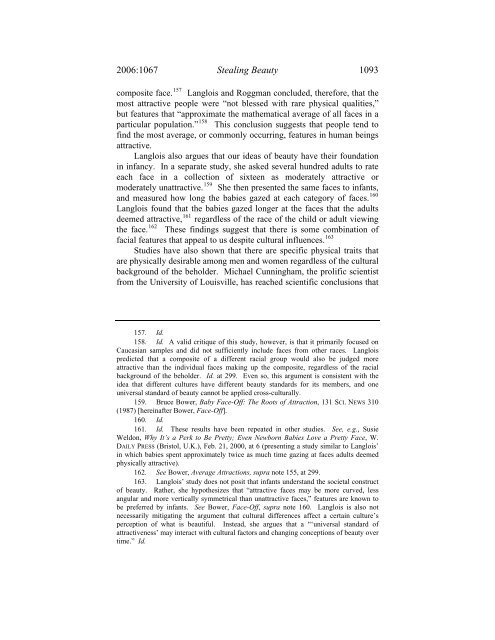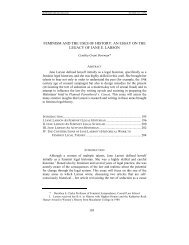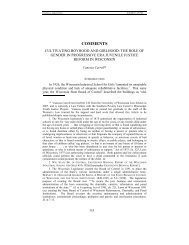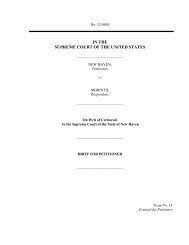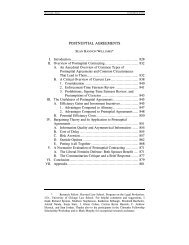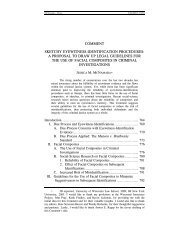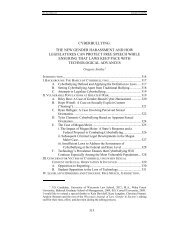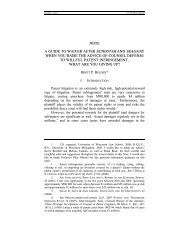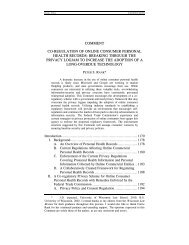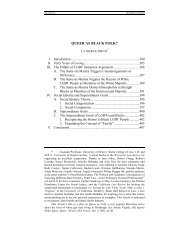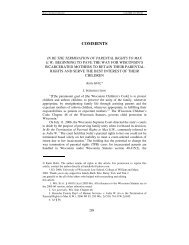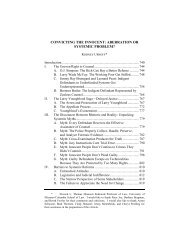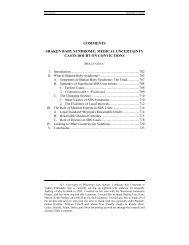Stealing Beauty: Pivot Point International v ... - UW Law School
Stealing Beauty: Pivot Point International v ... - UW Law School
Stealing Beauty: Pivot Point International v ... - UW Law School
Create successful ePaper yourself
Turn your PDF publications into a flip-book with our unique Google optimized e-Paper software.
2006:1067 <strong>Stealing</strong> <strong>Beauty</strong> 1093<br />
composite face. 157 Langlois and Roggman concluded, therefore, that the<br />
most attractive people were “not blessed with rare physical qualities,”<br />
but features that “approximate the mathematical average of all faces in a<br />
particular population.” 158 This conclusion suggests that people tend to<br />
find the most average, or commonly occurring, features in human beings<br />
attractive.<br />
Langlois also argues that our ideas of beauty have their foundation<br />
in infancy. In a separate study, she asked several hundred adults to rate<br />
each face in a collection of sixteen as moderately attractive or<br />
moderately unattractive. 159 She then presented the same faces to infants,<br />
and measured how long the babies gazed at each category of faces. 160<br />
Langlois found that the babies gazed longer at the faces that the adults<br />
deemed attractive, 161 regardless of the race of the child or adult viewing<br />
the face. 162 These findings suggest that there is some combination of<br />
facial features that appeal to us despite cultural influences. 163<br />
Studies have also shown that there are specific physical traits that<br />
are physically desirable among men and women regardless of the cultural<br />
background of the beholder. Michael Cunningham, the prolific scientist<br />
from the University of Louisville, has reached scientific conclusions that<br />
157. Id.<br />
158. Id. A valid critique of this study, however, is that it primarily focused on<br />
Caucasian samples and did not sufficiently include faces from other races. Langlois<br />
predicted that a composite of a different racial group would also be judged more<br />
attractive than the individual faces making up the composite, regardless of the racial<br />
background of the beholder. Id. at 299. Even so, this argument is consistent with the<br />
idea that different cultures have different beauty standards for its members, and one<br />
universal standard of beauty cannot be applied cross-culturally.<br />
159. Bruce Bower, Baby Face-Off: The Roots of Attraction, 131 SCI. NEWS 310<br />
(1987) [hereinafter Bower, Face-Off].<br />
160. Id.<br />
161. Id. These results have been repeated in other studies. See, e.g., Susie<br />
Weldon, Why It’s a Perk to Be Pretty; Even Newborn Babies Love a Pretty Face, W.<br />
DAILY PRESS (Bristol, U.K.), Feb. 21, 2000, at 6 (presenting a study similar to Langlois’<br />
in which babies spent approximately twice as much time gazing at faces adults deemed<br />
physically attractive).<br />
162. See Bower, Average Attractions, supra note 155, at 299.<br />
163. Langlois’ study does not posit that infants understand the societal construct<br />
of beauty. Rather, she hypothesizes that “attractive faces may be more curved, less<br />
angular and more vertically symmetrical than unattractive faces,” features are known to<br />
be preferred by infants. See Bower, Face-Off, supra note 160. Langlois is also not<br />
necessarily mitigating the argument that cultural differences affect a certain culture’s<br />
perception of what is beautiful. Instead, she argues that a “‘universal standard of<br />
attractiveness’ may interact with cultural factors and changing conceptions of beauty over<br />
time.” Id.


